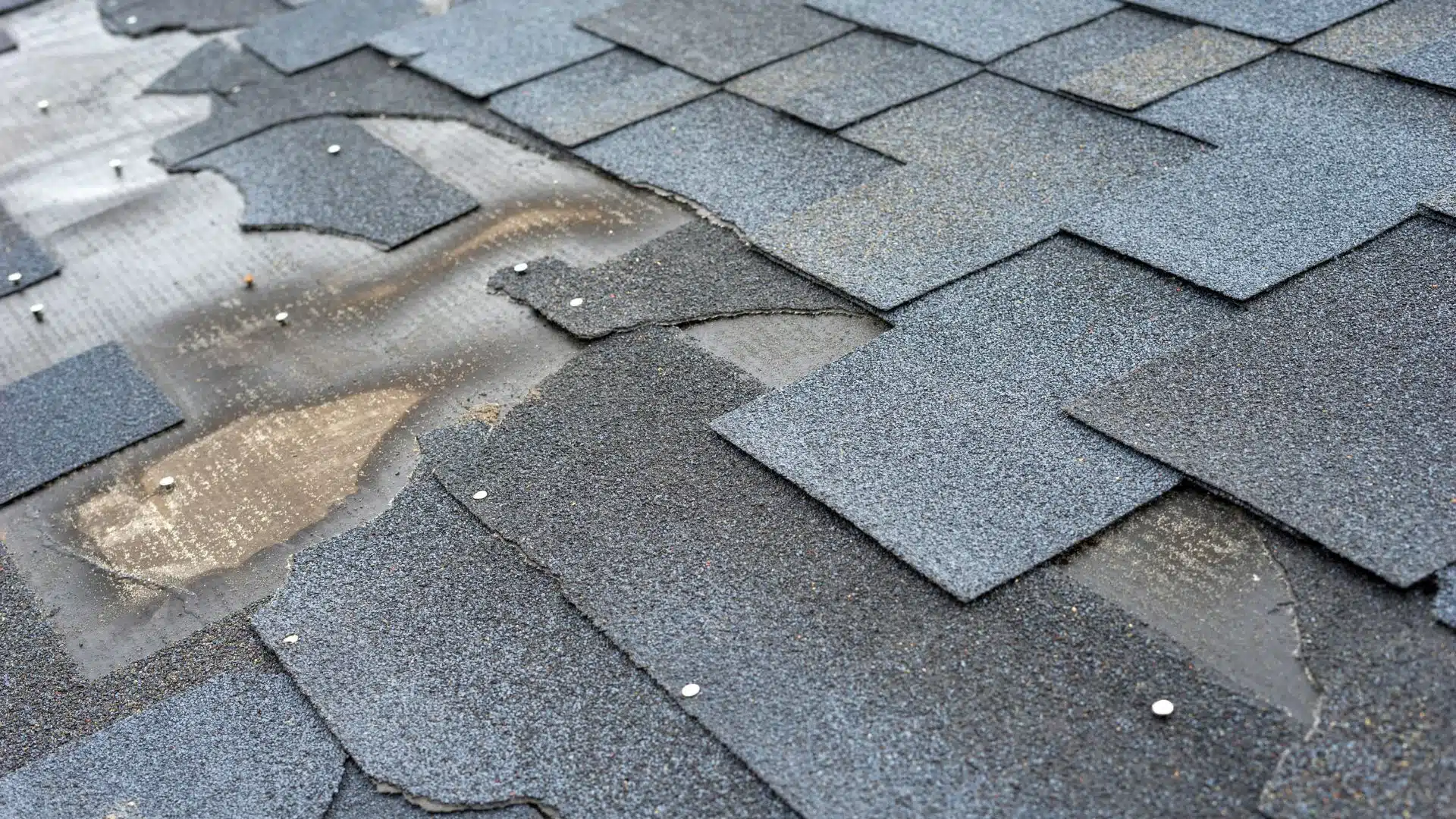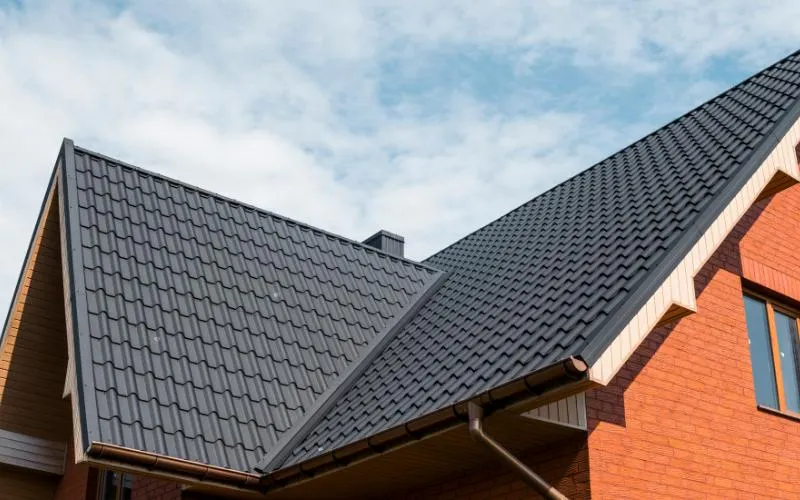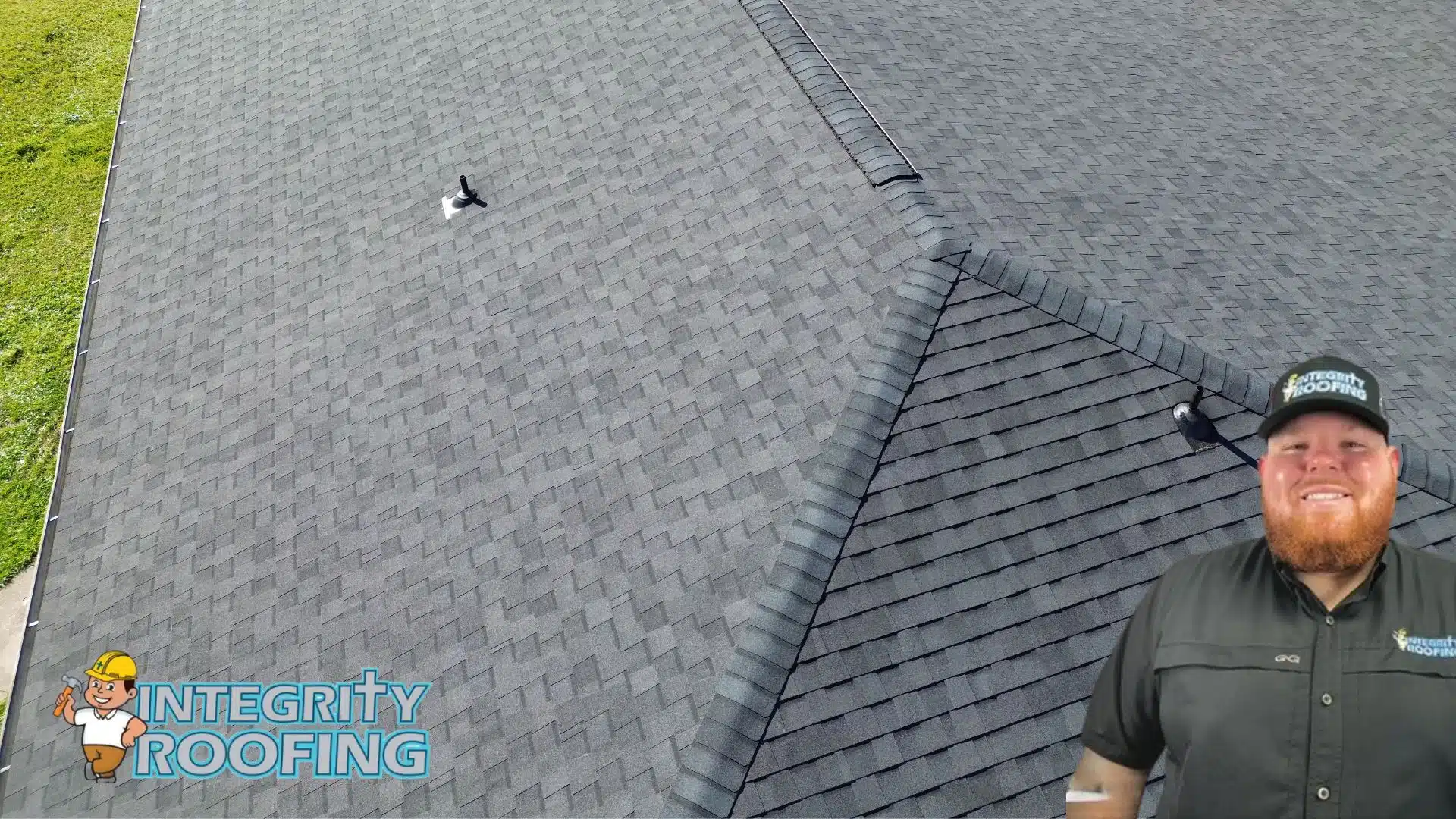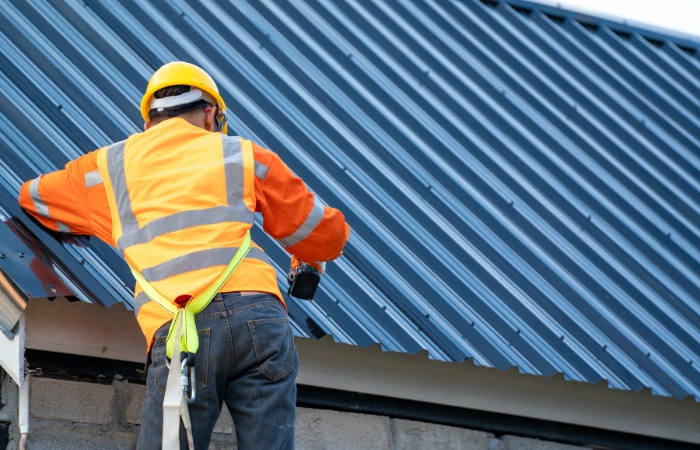Battling the MS Gulf Coast’s Unforgiving Storms
Living on the Mississippi Gulf Coast comes with its perks—coastal views, warm weather, and southern charm. But it also means bracing for hurricanes, high winds, and unpredictable storms that can wreak havoc on your roof. Homeowners here know that roof damage isn’t a matter of if, but when.
From wind-lifted shingles to hail-pocked surfaces, storm damage can sneak in quietly and snowball into costly repairs. That’s why understanding the most common types of roof damage and how professionals repair them is essential. Whether you’re preparing for the next storm or recovering from the last one, getting ahead of roof damage can protect your family and your investment.
If you’re searching for a roofer near me who knows how to deal with Gulf Coast weather, Integrity Roofing has your back. We’ve built our reputation on honesty, thorough inspections, and quality repairs that last.
The 5 Most Common Types of Roof Damage on the Mississippi Gulf Coast
1. Hail Damage
Hail damage is deceptive—it might not look catastrophic, but even small hailstones can bruise or crack shingles, knocking granules loose and shortening roof life. These surface blemishes might seem cosmetic at first, but over time, they can allow water intrusion and cause leaks.
If you notice pockmarks or discolored patches on your shingles after a storm, you might be dealing with hail impact. It’s critical to have a professional assess the damage. Some homeowners choose to upgrade to impact-resistant shingles after repairs to reduce future risk.
Concerned about your roof? Contact a roofer Gulfport MS homeowners trust to inspect for hail damage you can’t always see from the ground.
2. Wind Damage
Hurricane-force winds are nothing new on the Mississippi Gulf Coast. High winds can lift shingles, break seals, or tear materials clean off the roof deck. Even one missing shingle can let in water and lead to hidden damage beneath the surface.
Visible signs include curled shingle edges, displaced flashing, or entire rows of shingles gone missing. Sometimes debris slamming into the roof causes secondary issues, like cracked vents or punctures. Preventative solutions include reinforcing roof edges and using hurricane straps in vulnerable areas.
If your roof is looking worse for wear after a storm, don’t wait—call a roofer near me who understands Gulf Coast wind codes and restoration best practices.
3. Water Damage
Water damage is a silent intruder. After a storm, water may seep beneath damaged shingles or around vents and chimneys, eventually reaching your attic or insulation. Over time, this causes mold, rotting wood, and staining on your ceiling.
You might not notice water damage until it’s too late—by then, mold may already be present, or your roof decking could be compromised. That’s why it’s essential to get your roof checked after major rainfall or hurricanes, especially in areas prone to heavy water exposure.
At Integrity Roofing, we help you avoid expensive surprises. A roofer Gulfport MS residents recommend will spot leaks early and guide you through proper repairs.
4. Structural Damage
Not all damage is skin deep. Structural roof damage is one of the most serious—and dangerous—issues Mississippi Gulf Coast homeowners face. It can be caused by heavy debris (like falling limbs), prolonged water intrusion, or years of weather-related wear. Signs include sagging, soft spots, warped decking, or even visible holes.
Structural damage doesn’t just put your roof at risk—it compromises your entire home’s integrity. That’s why emergency inspections after major storms are so important. A professional will evaluate the decking, rafters, and load-bearing elements to ensure everything is safe and code-compliant.
If you suspect something’s wrong after a storm, don’t delay. Call a roofer near me with the tools and experience to assess and repair internal damage before it spreads.
5. Cosmetic Damage
Cosmetic roof damage may seem like a non-issue—but don’t ignore it. Minor dents, discoloration, or cracked shingles may not immediately affect performance, but they can hide deeper problems. Worse, they can reduce your property’s curb appeal and lower resale value.
Examples include hail-induced dings, algae streaks, and uneven shingle fading from sun exposure. While cosmetic in nature, these issues can still allow moisture to enter or create weak points if ignored for too long.
A roofer Gulfport MS homeowners count on will determine whether the damage is surface-level or a sign of something worse beneath. We’ll never recommend repairs you don’t need—but we’ll always tell you the truth.
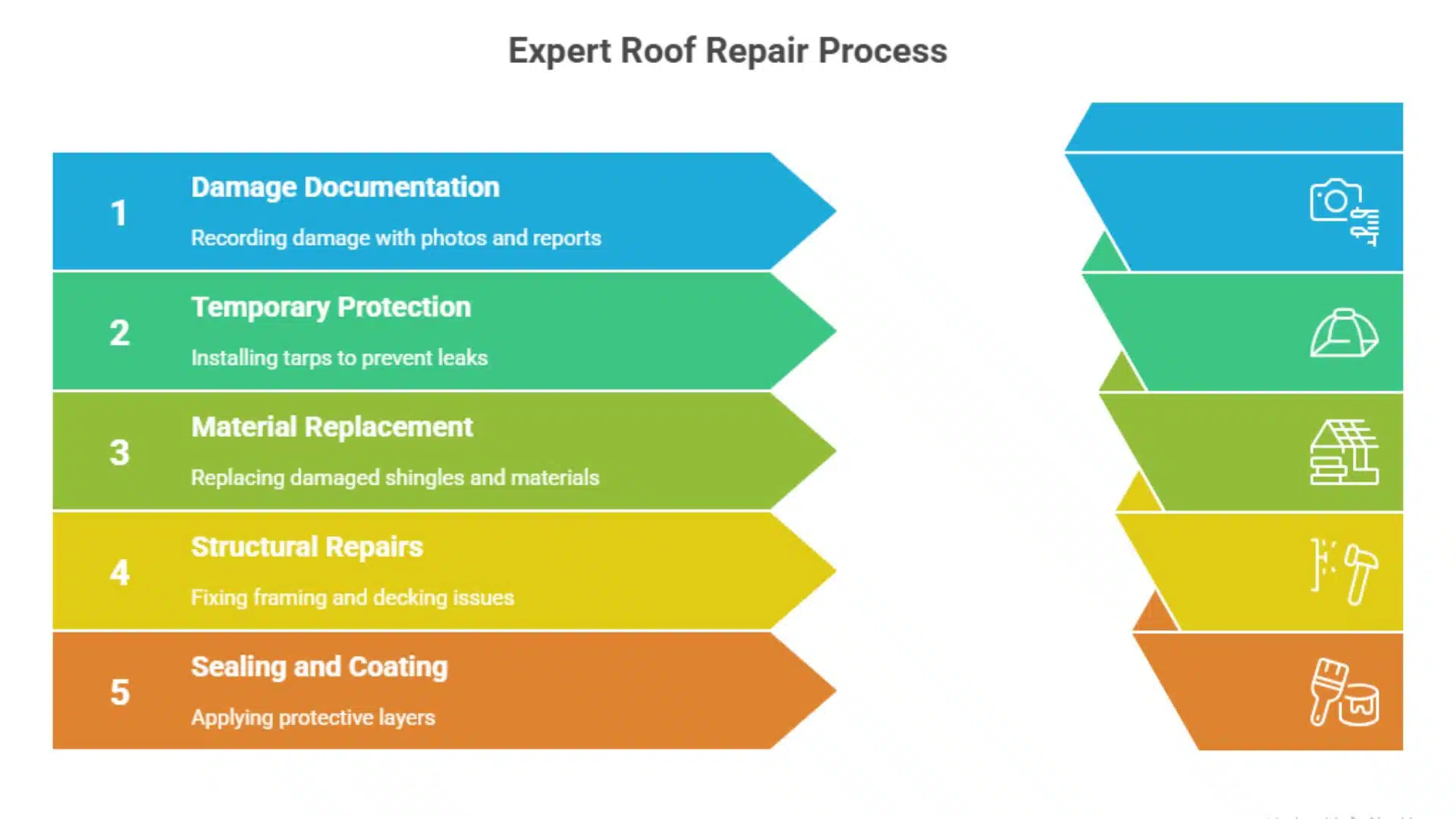
The Expert Roof Repair Process: Step-by-Step Guide
1. Initial Inspection
Every repair begins with a thorough inspection. A professional roofing contractor will check for damage to shingles, flashing, roof vents, gutters, and structural components—inside and out. We also examine the attic for signs of moisture, mold, or insulation damage.
Storm damage isn’t always obvious to the untrained eye. That’s why MS Gulf Coast homeowners need a roofing contractor who knows what to look for in our unique coastal climate.
2. Damage Documentation
Proper documentation is essential—especially if you plan to file an insurance claim. We take high-resolution photos, note material losses, and create a full report outlining needed repairs. This helps you get the compensation you deserve and ensures accurate repairs are made.
It’s one more way a trusted roofer Gulfport MS residents rely on delivers value beyond the hammer and nails.
3. Temporary Protection
If the roof is leaking or structurally exposed, our team will install emergency tarps or sealants. This prevents further water intrusion while we prepare a permanent repair plan. Think of it as a shield that buys you peace of mind.
Every roofer near me worth their salt understands that quick action can save thousands in interior water damage.
4. Shingle and Material Replacement
Once the damage has been documented and temporary measures are in place, the next step is replacing what’s broken. This includes torn or missing shingles, damaged flashing, underlayment, and sometimes even vent boots or ridge caps.
At Integrity Roofing, we don’t just replace—we upgrade. When possible, we install wind-rated or impact-resistant shingles to help your roof withstand future storms. We also color-match your existing shingles for a seamless finish.
Need peace of mind after a storm? Trust a roofer Gulfport MS homeowners depend on to restore your roof with precision and care.
5. Structural Repairs
If your inspection revealed framing damage, compromised decking, or roof sagging, structural repairs are non-negotiable. Our team may need to replace warped plywood, reinforce trusses, or correct framing issues to bring the roof back to safe condition.
These aren’t just aesthetic concerns—they’re safety issues. A weakened roof structure can collapse under stress, especially during future storms or under heavy rainfall.
Don’t leave your family’s safety to chance. Work with a roofer near me who understands Gulf Coast codes and structural integrity from the inside out.
6. Sealing and Coating
After materials are replaced and the structure is secure, we seal every vulnerable area—vents, flashing, joints, and around skylights or chimneys. Depending on the type of roof, we may apply a protective coating to enhance water resistance and UV protection.
This step is about more than stopping today’s leak—it’s about preventing the next one.
Looking for long-term protection? A roofing contractor Gulfport MS homeowners recommend will make sure your roof is sealed tight and storm-ready.
7. Final Inspection and Cleanup
Before we wrap up, we do a final walk-through to ensure every repair meets our quality standards—and yours. From fasteners to flashing, nothing gets overlooked. Then, we clean the job site thoroughly and leave your property in better condition than we found it.
At Integrity Roofing, our work isn’t done until you’re confident your home is protected.
For dependable follow-through, hire a roofer near me who finishes what they start—with integrity.
8. Ongoing Maintenance
Even a perfectly repaired roof needs routine maintenance—especially on the storm-prone Mississippi Gulf Coast. We recommend seasonal inspections before and after hurricane season. This proactive approach catches minor issues before they become major problems.
Routine care can add years to your roof’s life—and savings to your wallet.
Call a roofer Gulfport MS residents trust to schedule ongoing inspections and protect your home year-round.
Conclusion: Gulf Coast Weather Is Tough—Your Roof Should Be Tougher
Storm damage may be unavoidable on the Mississippi Gulf Coast—but that doesn’t mean you have to live in fear of the next forecast. Knowing the common types of roof damage and the expert repair process gives you the power to act fast and smart.
At Integrity Roofing, we believe in protecting homes with more than just shingles—we protect them with service, honesty, and craftsmanship that lasts.
If your roof’s been hit, don’t wait. Reach out to a Gulfport roofer who shows up, follows through, and puts your home first—every time.
✅ 5-Question FAQ Section (for blog content)
1. How do I know if my roof has storm damage?
Look for missing shingles, granule buildup in gutters, water stains on ceilings, or visible dents and cracks. A professional inspection is the best way to confirm hidden damage after a storm.
2. Will my insurance cover roof damage after a Gulf Coast storm?
Most homeowner’s insurance policies cover storm-related roof damage, but documentation is key. Work with a roofer who can provide detailed reports and photos for your claim.
3. How soon should I repair roof damage after a storm?
Immediately. Delaying repairs can lead to water intrusion, mold, and structural issues. Temporary tarping may be necessary while you wait for full repairs.
4. What kind of shingles are best for Gulf Coast homes?
Impact-resistant and wind-rated shingles offer better protection against hurricanes and hail. Ask your roofer about upgrading during repairs.
5. How often should I schedule a roof inspection in Mississippi?
At least once a year, and always after major storms. Proactive maintenance helps catch small issues before they become costly problems.

